|
|
Helicid Snails III: Mediterranean
Helicidae
|
![]() Explanation of
shell characters as means of identification.
Explanation of
shell characters as means of identification.
 Helix pomatia love dart. Picture: Peter Leonhardt. |
In contrary to the Ariantinae, there are never hairy juveniles among the Helicinae. The love dart (picture on the right) always has four blades in this group, the crown is distinctly visible. Among the Helicinae there are the nearest relatives of the Roman snail, among these numerous other edible species, some of which are of economic importance.
The banded snails (Cepaea) show very well the large variety of shell colours and patterns as a result of selection by snail eating thrushes.
Banded Garden Snail or White Lipped Snail - Cepaea hortensis (O.F. Müller 1774)
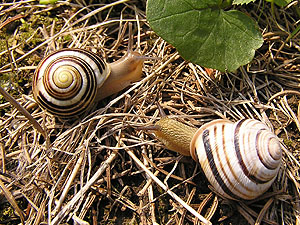
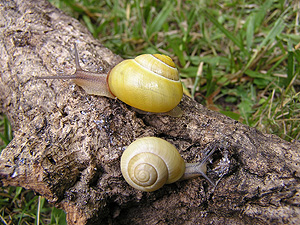 Left: Garden banded snail (Cepaea hortensis, left) and Viennese banded snail (Cepaea vindobonensis, s. below). Right: Garden banded snail (front) and grove snail (Cepaea nemoralis, s. below). [RN] |
Description: The white-lipped snail is characterised by its distinct white apertural lip, which may, though, in some cases also be brownish in colour. The shell, typical for a Helicidae snail, is spherical in form. The umbilicus is completely concealed by the apertural lip.
The finger-shaped mucus glands of the genital apparatus each have 4 fingers (gland protrusions) or more. The love dart's blades are forked longitudinally (see also: Koene, J. M. 2005).
Dimensions: W: 14 - 20 mm; H: 10 - 17 mm; N: 5 - 5˝. (Abbreviations).
Habitat and Distribution: In spite of the latter's name, the white lipped snail more often occurs in groves than does the grove snail (or brown lipped snail). In the mountains, the white lipped snail climbs as far as 2000 m above sea level.
It is widely spread in Western and Central Europe, from Northern Spain, France and the British Isles to Northern Norway and Southern Iceland, in the East as far as to the Baltic Sea countries, the Western Carpathians, the Northern and Southern Alps and adjacent karst countries.
Places where the species occurs in Northern America probably are due to introduction by man.
![]() Variations of the Garden Banded Snail (Cepaea
hortensis).
Variations of the Garden Banded Snail (Cepaea
hortensis).
Grove Snail or Brown Lipped Snail - Cepaea nemoralis (Linnaeus 1758) (Link)
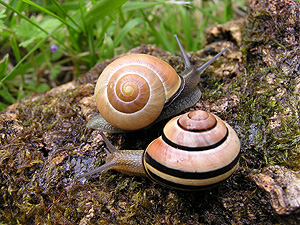
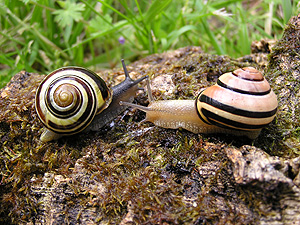
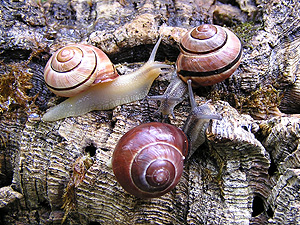 Different varieties of the grove snail (Cepaea nemoralis). Left: Rose coloured, unbanded and banded; Middle: Yellow and rose coloured (both banded). Right: Different shades of red. The snail on the left also has a distinct yellowish tinge.[RN] |
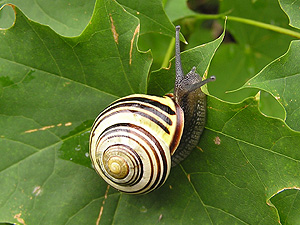 Five banded specimen of the grove snail. [RN] |
Description: The grove snail is also called brown lipped snail because of its distinct brown apertural lip. As in the white lipped snail the umbilicus is completely hidden behind it. The finger-shaped mucus glands (see above) only have three or less gland protrusions or fingers. The love dart's blades are not forked.
Dimensions: W: 18 - 25 mm; H: 12 - 22 mm; N: 5˝. (Abbreviations).
Habitat and Distribution: The grove snail mainly lives in bushes and open forests in plains and low mountain ranges of Western and Central Europe: In the South as far as Southern Portugal and Central Spain, through the Southern Alps into Southwest Hungary and Bosnia, in Italy as far south as the Basilicata, in the North into Southern Sweden, in the East as far as the river Oder.
The grove snail's area of distribution does not reach Vienna in the East.
![]() Variations of the Grove Snail (Cepaea
nemoralis).
Variations of the Grove Snail (Cepaea
nemoralis).
Viennese Banded Snail - Caucasotachea vindobonensis (A. Férussac 1821)
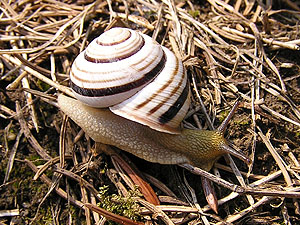 Viennese banded snail (Caucasotachea vindobonensis). [RN] |
Description: The Viennese banded snail differs from its previously described relatives by its distinctly ribbed shell surface. The apertural lip is light brown, but pales towards the suture, other than among the other described species. In general the shell is less colourful, whitish or light yellow.
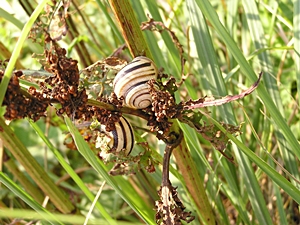 Viennese banded snail aestivating on a plant stem. [RN] |
Of the four or five distinctly dark bands only the lower are strongly coloured, the upper two much less so.
Dimensions: W: 20 - 25 mm; H: 17 - 21 mm; N: 5˝ - 6. (Abbreviations).
Habitat and Distribution: This species lives in open bushes and shrubs on hillsides in steppe and rocky country, in plains and warm hill countries.
Its distribution area stretches over all of the Carpathian area, the Eastern Alps, the Balkan peninsula as far as Thessaly, as well as the Northern Black Sea area. In the North it almost reaches the Baltic Sea.
In Germany, the Viennese banded snail occurs on Burgberg mountain near Donaustauf (Regensburg), where a local priest had introduced some snail species from Austria in the 19th century.
![]() Fischer, W.: "Cepaea
vindobonensis".
Fischer, W.: "Cepaea
vindobonensis".
Mountain Banded Snail - Macularia sylvatica (Draparnaud 1801)
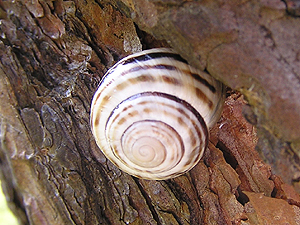 Mountain banded snail (Macularia sylvatica), aestivating on a tree in the Gorges de Court (Canton Bern, Switzerland). [RN] |
|
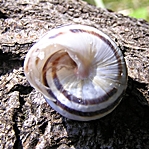 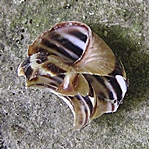 |
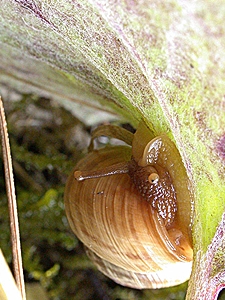 Mountain banded snail (Macularia sylvatica). Picture: © Stefan Haller, (schneckenfoto.ch). |
Description: Compared to the Viennese banded snail, the mountain banded snail has got a more compressed and smaller shell. Only in this species the shell is striped with irregular spiral lines. The bands usually are dissolved into spots (See especially picture on the right), the lowest band is narrow and rather far away from the umbilicus (See lower right picture). The apertural lip of a mountain banded snail is between rose coloured and light brown (See lower left picture).
Dimensions: W: 18 - 25 mm; H: 12 - 16 mm; N: 5 - 6. (Abbreviations).
Habitat and Distribution: The mountain banded snail depends on high air moisture, it inhabits open mountain forests, rocks and screes. Rarely found below 500 m (1500 ft.) above sea-level it climbs above 2700 m (8100 ft.) above sea-level in the Swiss Valais region.
The distribution area of Macularia sylvatica covers the French and West Swiss Limestone Alps and the Jura mountains (See picture description on the right). Sporadically it is found in the Rhine Valley between Schaffhausen and Karlsruhe. It has been introduced to Landsberg on Lech in Western Bavaria.
![]() Reference: Fechter, Falkner: "Weichtiere" (1990).
Reference: Fechter, Falkner: "Weichtiere" (1990).
![]() Francisco Welter-Schultes:
Cepaea silvatica species homepage.
Francisco Welter-Schultes:
Cepaea silvatica species homepage.
![]() Mollbase:
Cepaea sylvatica (According to Mollbase, the correct
spelling of the species name is sylvatica with a y).
Mollbase:
Cepaea sylvatica (According to Mollbase, the correct
spelling of the species name is sylvatica with a y).
Among the Helicinae, next to the banded snails, belong numerous other species. In addition to Helix and Cornu, there are other large terrestrial snails, such as Levantine snails (Codringtonia), Otala (e.g. Otala lactea, the milky snail) and the Iberian snails (Iberus gualterianus). Among the smaller species there are, for example, the sand hill snail (Theba pisana) and the chocolate banded snail (Eobania vermiculata).
Koene, J. M. (2005): "Love darts of land snails". Invertebrate Biology 124: 1 (PDF).

The
European banded snail project in the Darwin year 2009
![]() Part 3: Mediterranean Helicidae.
Part 3: Mediterranean Helicidae.
![]() -
Chocolate banded snail (Eobania vermiculata).
-
Chocolate banded snail (Eobania vermiculata).